We take for granted that energy is the lifeblood of the economy. It is the basic good that powers all human activity. Everything from transportation, agriculture, manufacturing to technology relies on energy in its various forms. Access to affordable energy not only enables a modern standard of living, it is absolutely fundamental to matters of economy and state security. In natural disasters like the ones we have recently witnessed in Western North Carolina and Florida, energy is not just an economic necessity but a matter of survival and dignity. These crises underscore the vital importance of reliable, affordable energy, especially in times of need.
In the evolving energy landscape, the balance between ambitious green energy goals and the rapidly expanding energy needs driven by emerging technologies like AI presents a critical challenge for policy makers and industry leaders alike. Focusing on this issue, at this year’s Danube Institute and Heritage Foundation joint Geopolitical Summit, academics and energy industry leaders were invited to speak on a panel entitled The Future of Energy: Green Dreams versus Real Needs?
The title’s dichotomy merits consideration, and what each detracts from the other in a zero-sum hypothetical has been the focus of energy-related debates for decades now. But the advent of artificial intelligence has thrown a monkey wrench into the debate. Both green dreams (carbon neutrality, net zero emissions, the complete elimination of all fossil fuels) and real needs (energy price, availability, reliability) now individually represent supply-side and demand-side challenges that will, left unexamined, reciprocally compound the same problems: insufficient supply, higher prices, and domino-style economic decline.
Real Needs: Exponential Growth of AI and Other Technologies
Artificial intelligence catches eyes because of its end-use potential. Rarely discussed, yet equally disruptive and critical, are its front energy requirements. According to Sara Vahkshouri, Professor and Chair of Center for Energy Security & Energy Diplomacy at the Institute of World Politics, electric power demand is about to increase dramatically in response to the advent of AI in a way that forecasters do not fully understand.
Whereas traditional energy demand forecasting trends are predictable based on population and GDP changes, ‘we have absolutely no idea’ how much energy we need to produce to support AI and crypto activity, remarked Vahkshouri. None of the major forecasting entities ‘from BP to EIA to IEA’ have a working model to predict the additional power generation necessary to support these exponentially growing technologies. This uncertainty makes AI ‘the monster—not elephant—but monster in the room’ for energy strategists, she continued.
Take for example Northern Virginia, home to data centers through which 70 per cent of global internet traffic is routed. Power suppliers in this region told Vahkshouri that they need an additional 24 Gigawatts (GW) of capacity by 2038 just to accommodate the demand increases from the data centers currently under contract. This demand forecast does not incorporate AI and Crypto-driven expansion, which is still underway, and remains unknown.
Put simply, utility power suppliers in Northern VA would likely need to build at least 26–30 new nuclear reactors (or equivalent capacity from other sources) in the next 15 years just to address increases in internet traffic from their existing data centers customers, not accounting for the wave of coming AI and blockchain processing and data center expansion.
‘Energy affordability and reliability are essential to economic stability’
Across the US, electricity suppliers will have to build 50–60 GW of capacity by 2030 to accommodate even the low-end projections of AI development, according to a McKinsey & Company analysis. In just two years, AI and crypto activity could increase global data center energy consumption by as much as 100 per cent, IEA reported.
The uncertainty around the pace and scale of demand growth is a challenge for data centers, electricity suppliers, and policy makers. What is relatively certain is that massive investment in new power gen is needed soon, so making the right decisions now on which sources to leverage is essential to maintaining equilibrium in this critical industry. Energy affordability and reliability are essential to economic stability. A large enough supply–demand imbalance could lead to more inflation and even recession, as we’ve seen recently in Germany.
How can leaders prepare? From where will the energy come?
Green Dreams: Overrated and Necessary
In the current landscape of Net Zero targets for governments, utilities, and major corporate energy consumers, it is generally assumed that renewable energy, given the quantity of investment being poured into it by these very institutions, will continue to expand to meet new demand. The most zealous call for complete retirement of all carbon-based power gen to be replaced by wind, solar, and other renewable energies.
Despite earnest intentions, intermittency and unreliability remain perennial problems for green advocates. Solar panels do not produce energy when the sun does not shine. Windmills do not produce energy when the wind does not blow. Neither produce to meet demand, and battery technology has not advanced enough to cover these gaps.
If the ‘dream’ is a power generation portfolio based exclusively on renewable energy sources, expect a nightmare. Swapping out abundant and cheap sources for intermittent (scarce and expensive) energy will necessarily drive prices up.
Abandoning reliable sources of energy would reduce overall quality of life, jeopardize the economy, and even military readiness. Germany, as mentioned above, is an unfortunate example. In lieu of a strategy that valued stability and reliability, they opted to decommission all of their nuclear plants to instead rely increasingly on renewables and Russian natural gas. Energy prices soared, especially through the first year of the Ukrainian war, and Germany is deindustrializing as a direct result. Manufacturers are shutting down or leaving the country, such as defense firm Rheinmetall, which has moved their Lynx fighting vehicle production to Hungary.
Ironically, the pursuit of green energy has led Germany back to burning lignite coal, a notoriously dirty and inefficient fuel, to mitigate their energy crisis.
‘Policy makers must take a pragmatic approach, encouraging supply and production expansion across every fuel type, wherever practical’
While the exponential growth of AI heightens immediate concerns about meeting energy demand, green energy ambitions must be evaluated through the lens of feasibility, affordability, and reliability. Panelists agreed: a broad, all-of-the-above approach is the best strategy to meet the energy demands of the future and ensure stable supplies in this essential industry, diversifying both fuel sources and trading partners. Because demand is ever-increasing, policy makers must take a pragmatic approach, encouraging supply and production expansion across every fuel type, wherever practical.
Hungary, host country of the Danube Institute, currently relies heavily on Russian gas and Russian nuclear technology for heating and power, respectively. As the war in Ukraine rages on, Hungary’s prospects for source and supplier diversification have significant implications on both national and European security—continued reliance on Russian energy means funding an adversarial country with a history of totalitarian oppression in living memory of millions of Hungarians.
Panelist Csaba Gondola, Chief Advisor to the Hungarian Energy Minister and Managing Director of the Institute for Energy Strategy, noted that Hungary has made serious strides in power diversification, despite lacking any significant fossil fuel deposits. Hungarian industry has installed seven GW of solar capacity, surpassing their 2030 target by 17 per cent and six years ahead of schedule. Solar accounted for 18 per cent of Hungary’s energy production in 2023, a world-leading percentage.
Yet, the Hungarian Energy Ministry’s measurement of the solar panels’ utilization shows they are not producing any power 83 per cent of the time. When the sun isn’t shining, turbines powered by Russian gas kick on.
When it comes to establishing an energy strategy that covers future demand and supports national security, supply must expand, not contract. There are no silver bullets. A broad array of technologies and sources are needed to piece together a robust and resilient energy base. All sources will be necessary, and pragmatism must trump ideology.
Related articles:








